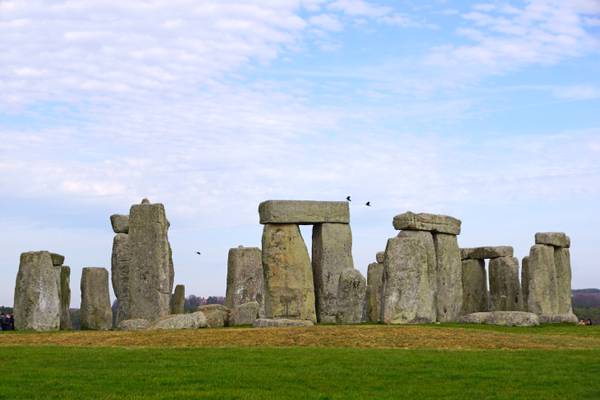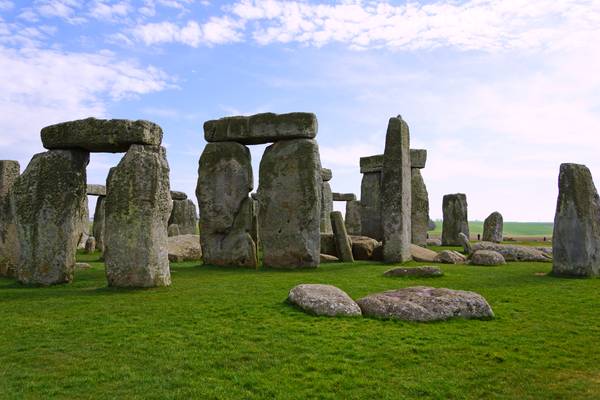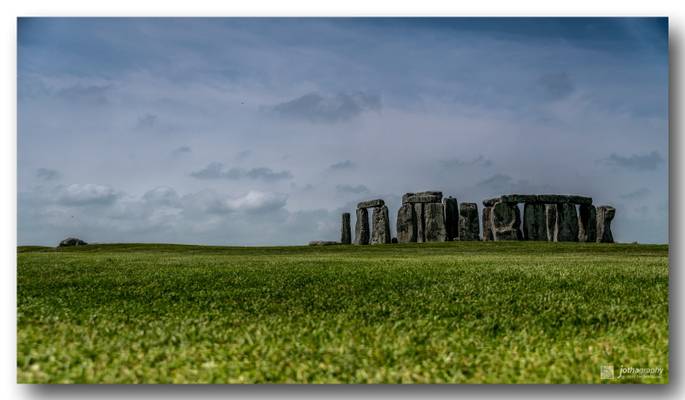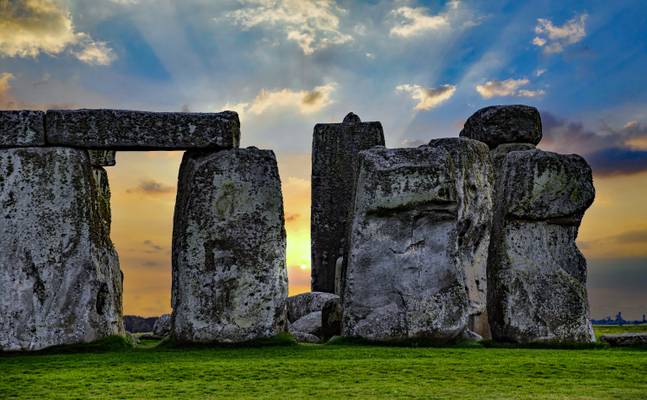
Stonehenge

by Dominic Nessi
- Stonehenge is a prehistoric monument on Salisbury Plain in Wiltshire, England, two miles (3 km) west of Amesbury. It consists of an outer ring of vertical sarsen standing stones, each around 13 feet (4.0 m) high, seven feet (2.1 m) wide, and weighing around 25 tons, topped by connecting horizontal lintel stones.
Inside is a ring of smaller bluestones. Inside these are free-standing trilithons, two bulkier vertical Sarsens joined by one lintel. The whole monument, now ruinous, is orientated towards the sunrise on the summer solstice. The stones are set within earthworks in the middle of the most dense complex of Neolithic and Bronze Age monuments in England, including several hundred tumuli (burial mounds).
Archaeologists believe it was constructed from 3000 BC to 2000 BC. The surrounding circular earth bank and ditch, which constitute the earliest phase of the monument, have been dated to about 3100 BC.
Radiocarbon dating suggests that the first bluestones were raised between 2400 and 2200 BC, although they may have been at the site as early as 3000 BC.
Stonehenge is regarded as a British cultural icon. It has been a legally protected Scheduled Ancient Monument since 1882, when legislation to protect historic monuments was first successfully introduced in Britain. The site and its surroundings were added to UNESCO's list of World Heritage Sites in 1986.
Stonehenge could have been a burial ground from its earliest beginnings. Deposits containing human bone date from as early as 3000 BC, when the ditch and bank were first dug, and continued for at least another 500 years.
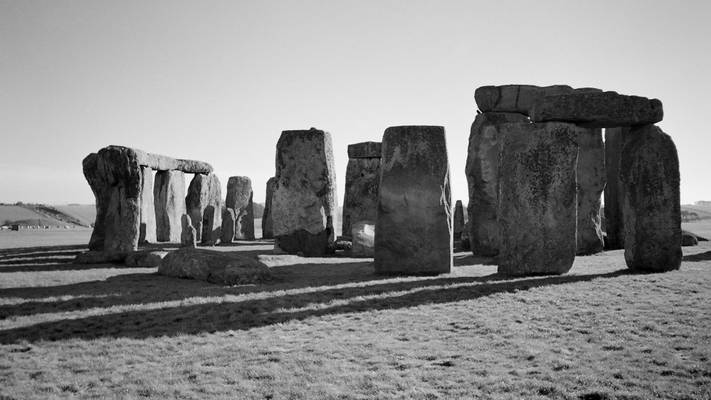
by Rob Oo
Stonehenge, Salisbury, UK.

by jim stephenw
Stonehenge is a prehistoric monument located in Wiltshire, England, about 2 miles west of Amesbury and 8 miles north of Salisbury. One of the most famous sites in the world, Stonehenge is the remains of a ring of standing stones set within earthworks. It is in the middle of the most dense complex of Neolithic and Bronze Age monuments in England, including several hundred burial mounds. Archaeologists believe it was constructed from 3000 BC to 2000 BC. The surrounding circular earth bank and ditch, which constitute the earliest phase of the monument, have been dated to about 3100 BC. Radiocarbon dating in 2008 suggested that the first bluestones were raised between 2400 and 2200 BC. Another theory suggests the bluestones may have been raised at the site as early as 3000 BC. The site and its surroundings were added to the UNESCO's list of World Heritage Sites in 1986 in a co-listing with Avebury Henge. It is a national legally protected Scheduled Ancient Monument. Stonehenge is owned by the Crown and managed by English Heritage, while the surrounding land is owned by the National Trust. Archaeological evidence found by the Stonehenge Riverside Project in 2008 indicates that Stonehenge could have been a burial ground from its earliest beginnings. The dating of cremated remains indicate that deposits contain human bone from as early as 3000 BC, when the ditch and bank were first dug. Such deposits continued at Stonehenge for at least another 500 years. Information from Wikipedia.
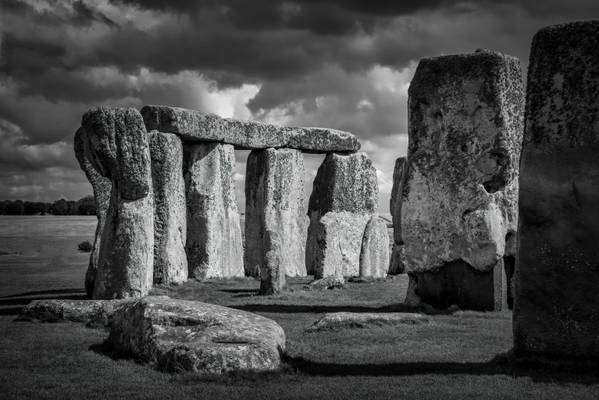
by Alan Taylor
Stonehenge is a prehistoric monument in Wiltshire, England, two miles (3 km) west of Amesbury. It consists of a ring of standing stones, with each standing stone around 13 feet (4.0 m) high, seven feet (2.1 m) wide and weighing around 25 tons. The stones are set within earthworks in the middle of the most dense complex of Neolithic and Bronze Age monuments in England, including several hundred burial mounds.
My website: Deep Mono Photography
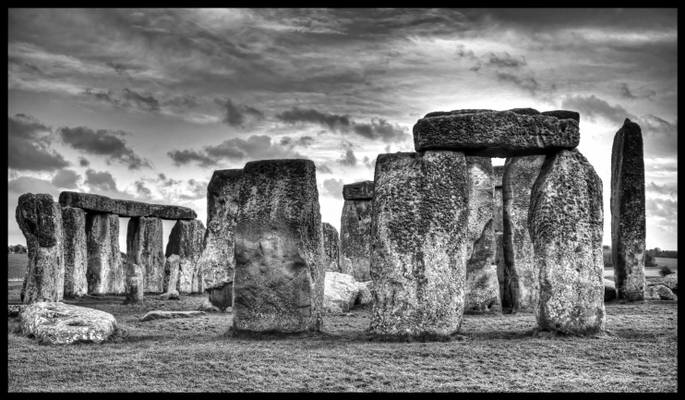
by jim stephenw
Stonehenge is a prehistoric monument located in Wiltshire, England, about 2 miles west of Amesbury and 8 miles north of Salisbury. One of the most famous sites in the world, Stonehenge is the remains of a ring of standing stones set within earthworks. It is in the middle of the most dense complex of Neolithic and Bronze Age monuments in England, including several hundred burial mounds. Archaeologists believe it was constructed from 3000 BC to 2000 BC. The surrounding circular earth bank and ditch, which constitute the earliest phase of the monument, have been dated to about 3100 BC. Radiocarbon dating in 2008 suggested that the first bluestones were raised between 2400 and 2200 BC. Another theory suggests the bluestones may have been raised at the site as early as 3000 BC. The site and its surroundings were added to the UNESCO's list of World Heritage Sites in 1986 in a co-listing with Avebury Henge. It is a national legally protected Scheduled Ancient Monument. Stonehenge is owned by the Crown and managed by English Heritage, while the surrounding land is owned by the National Trust. Archaeological evidence found by the Stonehenge Riverside Project in 2008 indicates that Stonehenge could have been a burial ground from its earliest beginnings. The dating of cremated remains indicate that deposits contain human bone from as early as 3000 BC, when the ditch and bank were first dug. Such deposits continued at Stonehenge for at least another 500 years. Information from Wikipedia.
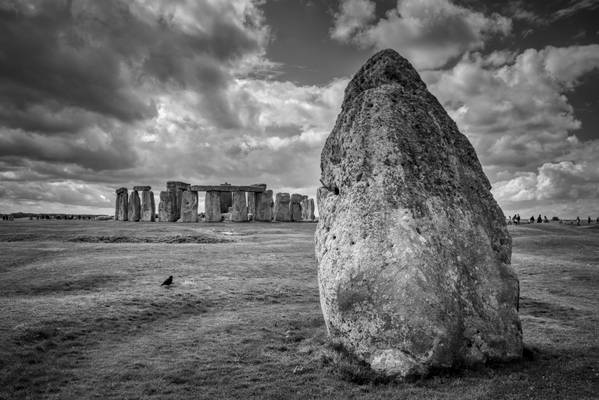
by Alan Taylor
The Heel Stone (or Hele/Heal Stone, sometimes also called "The Friar's Heel") is a natural stone that has not been worked or tooled. It lies about 250' away to the northeast from the centre of the stone circle; at the top of the Avenue, fractionally to the east of the main solstitial axis. www.stonesofstonehenge.org.uk
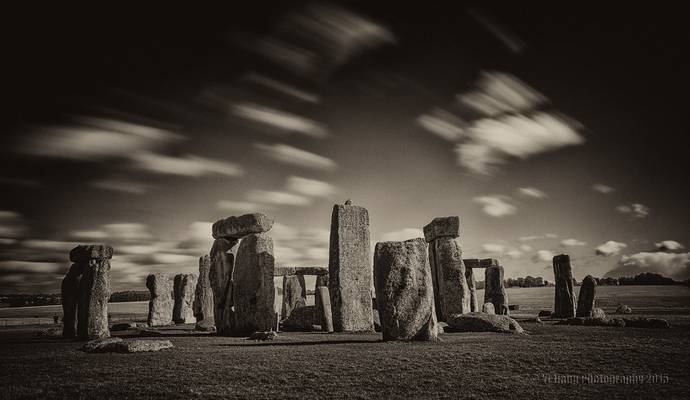
by Yi Jiang
Stonehenge, England

by Giuseppe Milo
If you like my pictures please support me buying a print from my shop www.pixael.com/en/pictures thanks!
You can follow me on https://www.facebook.com/giuseppemilophoto https://twitter.com/pixael_com https://instagram.com/pixael/
Thanks to all Phoide contributors to Stonehenge!
Most notably Alan Taylor, Andrey Sulitskiy and jim stephenw.

